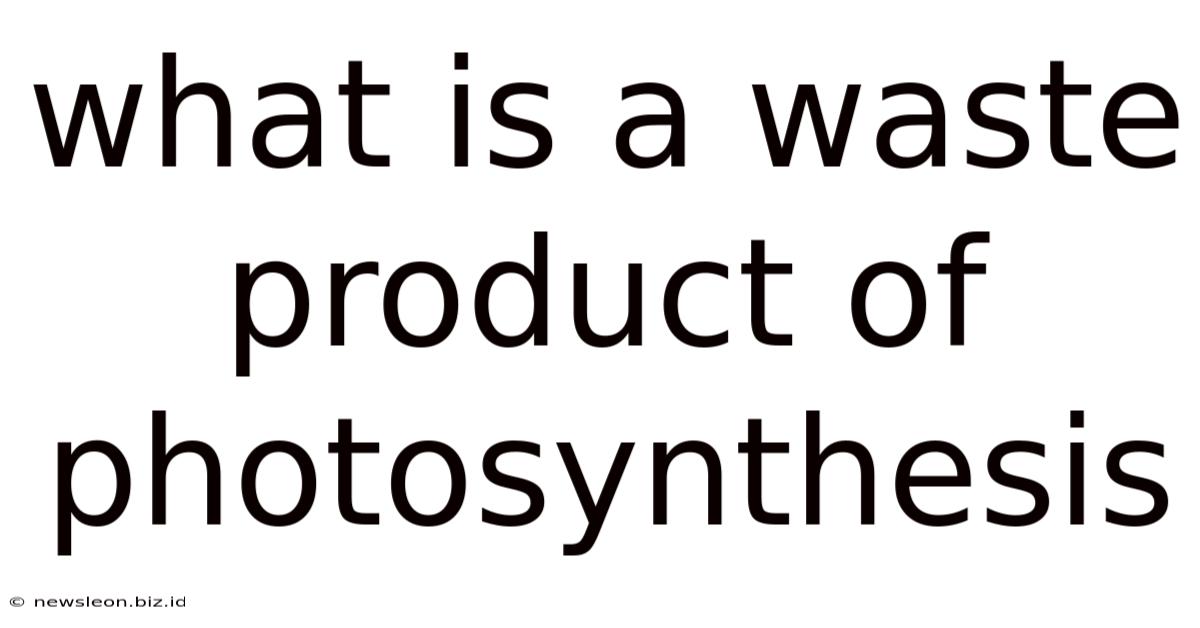What Is A Waste Product Of Photosynthesis
News Leon
May 03, 2025 · 5 min read

Table of Contents
What is a Waste Product of Photosynthesis? Understanding Oxygen's Crucial Role
Photosynthesis, the remarkable process by which green plants and certain other organisms convert light energy into chemical energy, is fundamental to life on Earth. While the primary product of photosynthesis is glucose, a vital sugar used for energy and building blocks, a significant byproduct is often overlooked: oxygen. This article delves deep into the role of oxygen in photosynthesis, exploring its production, significance, and the misconceptions surrounding it as a mere "waste product."
The Photosynthetic Process: A Recap
Before we delve into the waste product discussion, let's briefly revisit the core steps of photosynthesis. This process, occurring within chloroplasts, involves two main stages:
1. Light-Dependent Reactions: Capturing Light Energy
This initial stage harnesses light energy to split water molecules (H₂O) into its components: protons (H+), electrons (e-), and oxygen (O₂). This process, known as photolysis, is crucial because it provides the electrons necessary for the subsequent electron transport chain. The energy from the light is used to pump protons across a membrane, creating a proton gradient. This gradient drives the synthesis of ATP (adenosine triphosphate), the cell's primary energy currency. NADP+ is also reduced to NADPH, another crucial energy carrier molecule.
2. Light-Independent Reactions (Calvin Cycle): Building Glucose
The ATP and NADPH generated in the light-dependent reactions fuel the Calvin cycle, a series of biochemical reactions that convert carbon dioxide (CO₂) into glucose (C₆H₁₂O₆). This process utilizes the energy stored in ATP and NADPH to fix CO₂ and construct the glucose molecule, a crucial source of energy and building material for the plant.
Oxygen: A Byproduct or a Vital Component?
While textbooks often refer to oxygen as a byproduct of photosynthesis, this terminology is slightly misleading. While it's not the primary goal of the process, classifying oxygen as mere waste undervalues its immense ecological significance. The oxygen released during photolysis is a crucial byproduct that fundamentally shaped the Earth's atmosphere and enabled the evolution of aerobic life.
The accurate portrayal would be to call oxygen a released product or a byproduct of the water-splitting process that is essential for photosynthesis to occur. The process of photosynthesis itself aims to produce glucose, but the release of oxygen is an integral part of the mechanism that allows this goal to be achieved.
The Significance of Oxygen Production in Photosynthesis
The production of oxygen during photosynthesis has profound implications, including:
1. Shaping Earth's Atmosphere
The early Earth's atmosphere lacked free oxygen. The rise of photosynthetic organisms, particularly cyanobacteria (blue-green algae), billions of years ago, gradually transformed the atmosphere, enriching it with oxygen. This "Great Oxidation Event" was a pivotal moment in Earth's history, paving the way for the evolution of aerobic organisms.
2. Supporting Aerobic Respiration
Oxygen is essential for aerobic respiration, the process by which most organisms, including animals and many plants, extract energy from glucose. Aerobic respiration is far more efficient than anaerobic respiration, yielding significantly more ATP per glucose molecule. The oxygen produced by photosynthesis is, therefore, vital for the survival of countless organisms.
3. Ozone Layer Formation
Oxygen in the upper atmosphere forms ozone (O₃), which absorbs harmful ultraviolet (UV) radiation from the sun. The ozone layer shields life on Earth from the damaging effects of UV radiation, protecting DNA and preventing various health problems.
4. Supporting Diverse Ecosystems
The oxygen produced during photosynthesis sustains a wide range of ecosystems, from lush rainforests to vast oceans. The intricate web of life depends on the continuous production of oxygen, which underpins the survival of numerous species.
Misconceptions about Oxygen as a "Waste Product"
The term "waste product" implies something useless or harmful. This is inaccurate when discussing oxygen in the context of photosynthesis. Oxygen is not simply discarded; it is released into the atmosphere, where it plays an essential role in various biological processes. It is a valuable resource rather than waste. The term 'byproduct' is more appropriate.
Beyond Oxygen: Other Byproducts of Photosynthesis
While oxygen is the most prominent byproduct, other minor byproducts are also produced during photosynthesis, depending on the specific plant species and environmental conditions. These can include:
- Water: While water is a reactant in the light-dependent reactions, some water may also be released as a byproduct under certain conditions.
- Hydrogen Peroxide (H₂O₂): This reactive oxygen species can be formed as a byproduct of photolysis. However, plants possess mechanisms to detoxify hydrogen peroxide, preventing damage to cellular components.
- Reactive Oxygen Species (ROS): These are highly reactive molecules containing oxygen, such as superoxide radicals and hydroxyl radicals. ROS can be produced as byproducts under stress conditions, like high light intensity. Plants have antioxidant defense systems to mitigate the damage caused by ROS.
Conclusion: The Vital Role of Oxygen
Oxygen, frequently referred to as a byproduct of photosynthesis, is far from mere waste. Its production is an integral part of the photosynthetic process, and its release into the atmosphere has been crucial for the evolution and maintenance of life on Earth. The term "byproduct" more accurately reflects its role, acknowledging its significance without diminishing its crucial contribution to the planet's ecosystems and the survival of countless organisms. Instead of viewing oxygen as a waste product, we should recognize it as a vital component of the Earth’s life support system, a testament to the intricate beauty and interconnectedness of biological processes. Understanding this nuance is crucial for appreciating the profound impact of photosynthesis on our planet.
Latest Posts
Related Post
Thank you for visiting our website which covers about What Is A Waste Product Of Photosynthesis . We hope the information provided has been useful to you. Feel free to contact us if you have any questions or need further assistance. See you next time and don't miss to bookmark.